Overcrowding in low-Earth orbit
One consequence of opening up access to space, however, is increased congestion. Low-Earth orbit, the prime real estate surrounding the planet that is still relatively close to the surface, is already becoming a crowded place.
Speckled among the operational satellites in low-Earth orbit are thousands of tons of space debris, ranging from tiny flecks of paint to spent rocket parts to huge defunct spacecraft that have languished in orbital graveyards for decades. Adding more satellites to the mix not only increases the chances of a catastrophic on-orbit collision, but also pushes humanity closer to a perilous tipping point, beyond which certain parts of low-Earth orbit may become too cluttered and risky to operate in safely.
“We’re really on borrowed time before we have another big collision,” Weeden said. “There are thousands of close calls every day in orbit.”
In 2021, there were 1,702 new satellites launched into Earth orbit, bringing the total number of satellites operating in that part of space to 4,852, according to the Union of Concerned Scientists. That figure is nearly double the number of satellites that were operating around Earth in 2018, merely three years before.
Much of the recent overcrowding in orbit is exacerbated by companies such as SpaceX and OneWeb that are assembling huge megaconstellations consisting of tens of thousands of internet satellites around Earth. Amazon similarly announced plans this week to launch thousands of communication satellites into low-Earth orbit to provide high-speed internet around the world.
But placing all the blame on these megaconstellations is oversimplifying the problem, said Darren McKnight, a senior technical fellow at LeoLabs, a California-based aerospace company that operates networks of ground-based radars and tracking systems to monitor objects in low-Earth orbit and map their movements.
For one, operational satellites make up only a small fraction of the total number of objects in low-Earth orbit that pose collision risks, he said. And unlike defunct spacecraft that have languished in orbit for decades, most newer satellites can be maneuvered out of harm’s way, if necessary.
It has also become standard practice for satellite operators to have an end-of-life plan to cut down on the accumulation of space junk. These strategies include purposefully commanding a spacecraft to “deorbit,” or burn up harmlessly in Earth’s atmosphere, or strand it in a higher, “graveyard” orbit away from the most congested sections around the planet.
Still, the risks are serious. And the amount of debris in space is expected to grow as launches continue. McKnight said “bad neighborhoods” have already emerged — areas in low-Earth orbit where big clouds of debris pose very real threats.
“There are certain places in Earth orbit where we are destined to have a major event within the next five to 10 years,” he said. “We’re looking at a 10 to 15 percent probability of a collision, which sounds unlikely, but by leaving these objects in orbit since the mid-’80s, we’re rolling the dice a lot.”
These risks were amplified by a series of recent anti-satellite missile tests — one conducted by China in 2007, one by India in 2019 and one carried out by Russia last year — and a separate accidental collision between two satellites in 2009. Each event is estimated to have produced thousands of pieces of debris larger than the size of a golf ball, and even smaller, harder-to-track objects, according to the Secure World Foundation, a nongovernmental organization that focuses on space policy.
LeoLabs is just one of a slew of commercial companies trying to boost situational awareness in space and help preserve low-Earth orbit. In addition to LeoLabs’ exhaustive mapping and tracking, companies such as Astroscale are working on ways to extend the lives of satellites in space and developing technologies to actively remove objects from orbit.
Part of the problem is that while launches are subject to domestic regulations in individual countries, there is no international body to oversee what happens in orbit. Policies have yet to catch up with the industry’s growth, and it’s unclear if any binding global agreements can be achieved anytime soon.
“It’s like we’re building the plane as we’re flying it,” Koller, of The Aerospace Corp., said.
Yet, with society’s reliance on satellite systems for everything from telecommunications to security and defense, the stakes for maintaining sustainability in space are high, said Weeden, who also serves as chair of the Commercial Space Transportation Advisory Committee, part of the Federal Aviation Administration.
“All of us around the world are users of space, whether or not our country has satellites in orbit,” she said. “Our daily lives are dependent on space, so I feel passionately that this is a galvanizing item for humanity.”
Source: | This article originally belongs to Nbcnews.com











